Fishing Crankbaits
Choosing And Using Crankbaits
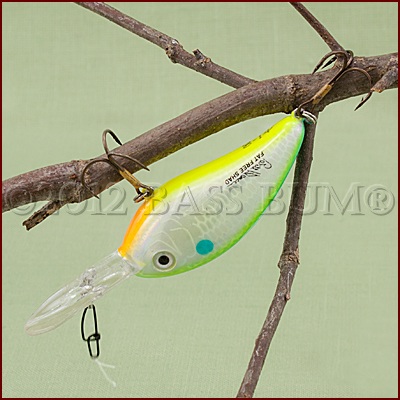
Many bass anglers prefer fishing almost any lure over fishing crankbaits. The very thought of all those treble hooks and all the things under water, besides fish, into which they can snag turns them toward bass fishing lures a bit more weedless, more user friendly if you will.
Furthermore, the vast number of shapes, sizes, colors, dive depths, lip sizes and broad range of costs, from a couple of bucks to as much as twenty, can overwhelm the average angler and his pocketbook.
If you're one of these reluctant crankbait fishermen I urge you to rethink your position. Anytime you're fishing crankbaits you're capable of catching bass around and in most forms of structure and cover as well as across the water column from 1 foot to 20 feet.
Here we want to explore the traditional crankbait. A fishing plug that is shad shaped with a diving lip. Lipless crankbaits and large deep diving crankbaits are discussed elsewhere.

Choosing A Crankbait
What do we consider when deciding the best crankbait to use at any given time and place? Some criteria are the following:
- Water depth,
- Line diameter and material,
- Bill shape and size,
- Casting Distance,
- Structure, Cover or Open Water
- Size - Match the hatch when possible.
- Color - Is it what the fish sees or what the angler sees that matters most?
- Rattle or No Rattle - Sometimes quite is better, sometimes not.

Depth And Line Diameter
The Most Important Considerations
Though I've never scuba dived I've seen many underwater films of bass. I'm always stunned by the number of bass that are under a dock or in and around cover which completely ignore a lure in their midst. The lure is above them, below them or too far away. If they aren't in an aggressive, feeding mood you're going to have to get the lure as close to them as possible.
That's where depth comes in. Get it close enough to them to hyper-stimulate their senses and there is a good chance you may trigger a reaction strike.
So if you have determined the depth at which the bass are hanging out (we'll discuss depth finders elsewhere) pick crankbait lures that dive to that depth. Seems sensible enough, right?
|
Bomber Fat Free Shad, Pearl White, Run Depth 8-14 Feet. 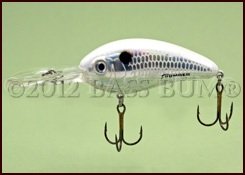 |
Rapala DT20, Pearl Grey Shiner, Run Depth 20 Feet. 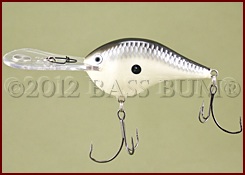 |
|
Strike King Square Bill, Bluegill, Run Depth 3-5 Feet 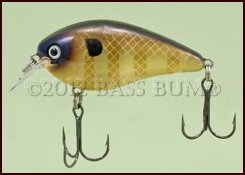 |
Rapala Thug, Chartreuse Shad, Run Depth 4-8 Feet 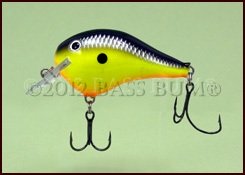 |
The lures shown above reflect some different bill types and maximum running depths as indicated by their manufacturers.
There are three depth ranges for crankbaits. I'm talking fishing for bass here, and casting, not trolling.
- Shallow Running - 0-6 feet
- Medium Running - 6-12 feet
- Deep Running - greater than 12 but less than 20 feet
Most manufacturers print maximum diving depth of the enclosed fishing plug on their packaging. Now this has most likely been determined from testing the lure on "light" line, possibly lighter than you would actually use fishing it. So consider it your starting point only.
Line Diameter And Material
We all know that friction is resistance to motion. There is a direct correlation between fishing line diameter and the amount of friction generated between the water and line during retrieve.
SIMPLE FACT: The larger the line diameter, the more friction generated and the less deep will go the crankbait.
| Brand | Product | Diameter |
|---|---|---|
| Berkley | Trilene TransOptic | .011" |
| Berkley | Trilene Sensation | .011" |
| Berkley | Trilene XT | .014" |
| Berkley | 100% Fluorocarbon | .012" |
| Sufix | Elite XT | .014" |
| Stren | Original | .012" |
| Stren | Extra Strength | .012" |
| PLine | CXX Copolymer | .013" |
| PLine | CX Copolymer Fluoro Coated | .010" |
When fishing crankbaits figure that a drop of .001-inch in line diameter can add close to a foot increase in depth on a long cast.
So How Does This Figure Into Crankbait Choice?
Let's say you're on the water fishing crankbaits. You see fish on your depth finder at 12 feet, "There they are, right there, at 12 feet just over that brush pile. I don't have a crank bait that goes deeper than 10', crap!"
OK, so yours go to only 10' on the on the 12lb test on your reel. But what about that other rod/reel setup you have with you, the one with 8lb test line? Try that one with your crankbait. You will likely pick up an extra foot, maybe two with this rig. There is a trade off however. You run the chance of losing more crankbait lures when fishing crankbaits on lighter lines.
What About Line Material and Its Impact On Depth?
Monofilament - Fluorocarbon - Braid
Some lines float while others sink. It's as simple as that. Monofilament floats, fluorocarbon sinks. When you're talking depth this has a bearing.
Monofilament - remains the choice of some of the very top professional bass fishermen. This line is easy to cast and has built in stretch. Positive traits for fishing crankbaits. When combined with a relatively soft, flexible rod the chance of solid hook sets increases as the bass has more time to enhale the lure and hook itself with the help of the angler's sweep set.
Fluorocarbon - has many advantages for bass fishermen but here, talking about fishing crankbaits, we're interested really in just two, (1) the fact that it sinks and (2) that it's tougher, more abrasion resistant than monofilament. Because it sinks it will help take a crankbait deeper by feet, not inches, and the toughness makes it a good choice if fishing crankbaits around around heavy cover or when bouncing it off bottom structure.
However, its lower stretch and heightened sensitivity can work against a crankbait angler the same as braids do, that is, cause too quick a reaction on the part of the angler resulting in the bait being pulled away from the bass.
Braids - are thinner than monofilament or fluoro and can take crankbaits deeper. They also have a greater sensitivity which some argue allows feeling the strike better at long distance as well as "sweep setting" the hook because of its low stretch.
Perhaps this is so if the angler has paired his braid with a soft tip rod and carefully monitored his "drag" insuring it is set at its loosest. If not, he will probably pull many lures away from the bass due to overly quick reaction or simply rip the hooks from the fish's mouth because of braid's lack of forgiveness.

Bill Size and Shape
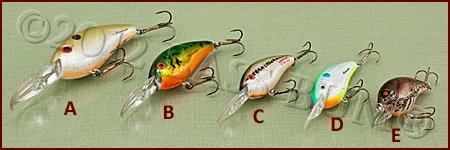
Short Lip
A short lip, sharply angled downward from the body means a shallow dive. Simply, the shallower the crankbait is intended to dive the shorter and more steeply angled from the lure's body will be the lip. This configuration also creates a more pronounced side to side wobble.
Long Lip
The longer the lip on a crankbait the deeper it's going to dive. The straighter the lip extends from the body of the fishing plug, the deeper it will dive. This design also produce a tighter wiggle action.
Casting Distance
A fundamental truth is that the longer the cast, the deeper a lure runs, at least for a short distance.
It has been stated by Ron and Al Linder (of In Fisherman and TV fame) that a "deep diving crankbait" takes fully 1/3 of its retrieve to reach its its maximum depth where it will run for another 1/3 of its retrieve and then expend the final third of its retrieve rising back to the angler. This means its in the "strike zone" for but a third of the retrieve time. It also means that with deep diving crankbaits unless you achieve a very long cast, in excess of 70', the lure probably never reaches its maximum depth.
Listen, consistently making a casts greater than 70' fishing crankbaits is no easy task. That's the average cast for most anglers. Chunking one 100'or even farther, as do some pros, is something to be proud of.
A book called Precision Casting written in 2000 by Steven Holt and Mark Romanack is an exhaustive study of the depths a fishing plug can go and the influences that affect that ability. Basically, they found that the typical dive path after a 70' cast reached 60% its maximum depth within the first 10' of the retrieve. Don't get excited. They also found that despite this rather rapid dive in the first 10' the lure wouldn't reach its full maximum till it was between 12-30' of the end of the retrieve!
What's this mean? It means most of us have been fishing crankbaits incorrectly and rarely reaching our intended target.

Choosing Your Crankbait Size
Only the bass can really know the preferred size of crankbait, lure, or even live bait it wants on any given day. We fishermen can only guess. But we can make educated guesses based on the following seasonal considerations:
Spring - In spring and fall, as bass move shallow, they will include baitfish and crawfish in their diets. You can count on the fact that in spring many baitfish in reservoirs, like shad, will be young and small (1-3"). Crawfish will be coming out of hibernation and many will be small as well. Choose your crankbait's sizes accordingly.
If heavy spring rains muddy the water you might want to up size your lures to increase visibility and water disturbance.
Summer In summer bass will focus on baitfish in deeper water and these will tend to be larger. Their dinner table will also include crappie and bluegill that are bigger mouths full.
Additionally, if you're night fishing crankbaits in summer an up size to larger crankbait lure is in order to increase visibility and water disturbance.
Fall This time of year the bass move shallow in pursuit of baitfish migrating into the creeks. These baitfish have had a season to grow so larger baits (3-5") are in order.
If fall rains muddy the water and the water is also cold, well, good luck with crankbaits.
Winter This time of year takes bass deep where they encounter larger forage. Larger, deep diving crankbaits get down to them. In shallow, cold water both the bass and the forage will be sluggish so downsize to smaller lures and fish them slowly.
What about mouth size?
Should you downsize for smallmouth bass? I don't change lure size based on whether I'm fishing crankbaits for smallmouth or largemouth bass. Bass are incredibly aggressive predators that will strike at just about anything that looks and sounds tasty. They'll deal with the size after they have hold of it. Too big? "Ptooey"!
But they just might get stuck with a treble hook as they spit it out. So don't sweat over "mouth size" too much.

Color Selection
With bass fishermen much discussion is had concerning lure color and fishing crankbaits is no exception. If you read scientific studies about the bass' sense of sight and color recognition you almost have to think the emphasis on lure color is a lot of "hooey".
Well I'm not sure the bass have read the studies. Granted, color is probably not the first consideration in whether a bass strikes or not, but I'm convinced it plays a "part" in the whole of its decision.
If reservoir bass are feeding on shad in the creeks in the fall of the year and you toss both a Tennessee shad colored crankbait and another that's painted "deer hunter orange", I feel certain the Tennesse shad will likely get the nod. All things being equal. What do you think?
Without engaging in writing a college dissertation about color, let's look at a few "reliable" guidelines gleaned from years of experience fishing crankbaits by weekend (Bass Bums) and professional bass fishermen.
- Winter means reservoir bass are focused on shad. A silver or white lure with a black back and maybe a bit of flash mixed in is the best ticket.
- Pre-spawn on reservoirs sees the bass begin to move to shallow water and crayfish become a larger part of bass' dinner preference. Choose reds, browns, greens, orange and black combinations. Post spawn the bass are ravenous. Grab some that are citrus/blue, pearl white, chartreuse with a green back and some lighter colors with a touch of orange belly or throat.
- In natural lakes perch as well as bluegill color schemes score.
- Dark water calls for more vibrant colors including chartreuse combinations and firetiger color schemes.
- Clear water requires natural colors for best success.
Colorful crankbaits are great fun for we fisherman. I've got a ton of different colored crankbaits myself. But when it comes to actually fishing crankbaits, well, first get the depth right and put a crank in their face. Then maybe add a little rattle, or maybe not. After that, the lure's color will play a part in causing them to strike.

To Rattle Or Not To Rattle, That Is The Question
Does sound help or hurt when fishing crankbaits? Like so many things in bass fishing, it depends.
All crankbaits create sound as they travel through the water. If a lure has no built in rattle it still creates sound from water turbulence, banging against objects and its hooks clacking against its body. Wooden fishing lures have different sounds than do plastic lures. Retrieve speed alters the sound of a lure. It goes on and on. So the questions seem to be when and how much sound serves to stimulate or depress a bass' decision to strike.
The most critical consideration when fishing crankbaits is getting your lure in the strike zone. If you're not there no amount of "rattle" will help, unless you run into the most aggressive, most ill tempered bass around. That guy might travel 20-30' to strike a lure that's making noise he finds irritating. Most of his buddies won't.
When fishing crankbaits follow the following guidelines and you'll be fine. If the fish are aggressive and actively feeding, the water is stained or muddy and warm, or you're in a good bit of cover, use a rattling crankbait. In cool, clear water where bass are cautious and easily spooked and are therefore relatively inactive, use "silent" crankbaits.
For more information about a bass' sense of hearing click here.
Tackle Considerations
Graphite fishing rods or fiberglass fishing rods? Which makes the best crankbait rod?
- Fiberglass Rod: The argument here is that since these are less sensitive than graphite rods the hook set will be delayed by the angler thereby allowing more time for the bass to suck in the lure.
- Graphite Rod: Graphite rods are thought to have heightened sensitivity. Some criticize this, feeling it will cause an angler to react too quickly and pull the lure away from the bass. It's also felt that a "positive" to graphite is that this sensitivity gives the angler an edge allowing him/her to "feel the bottom" better than with a fiberglass rod.
Whichever rod you choose for fishing crankbaits, it should have a soft flexible tip and a good backbone. Length should be 7' to 7 1/2'. The long length helps greatly in making long casts.
Reel Gear Ratio Is Important Too
When fishing crankbaits speed can work against you. In fact, reeling too fast will actually cause your crankbait to rise in the water column, not dive. Follow the lead of the pros. Many of them chose to use medium speed reels that have gear ratios of 5.1:1. A reel with a large spool capacity is also a good choice because it allows you to make the long casts "necessary" to effectively get your crankbait to its maximum depth.

Return To Crankbaits From Fishing Crankbaits
